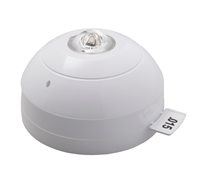
An Introduction to EN54 Part 23 and Visual Alarm Devices
In this article we give an overview of EN54 Part 23 and Visual Alarm Devices, and showcase best practice for their use.
EN54-23 was published in the UK in 2010 and became mandatory on 1st January 2014, after which any Visual Alarm Device (VAD) newly installed and used as the primary means of warning as part of a fire alarm system must conform to it.
Originally scheduled for 31st March 2013, a lack of product availability from manufacturers delayed its introduction. A key stimulus for its introduction is the Equalities Act 2010.
Fire detection and alarm systems are intended to alert occupants of a fire within the building. It is common to use a mix of audible and visual alarms to do so, and compliant VADs ensure the system generates an effective warning for all occupants of a building. If the primary warning is visual alarms, it must be effective in alerting hearing impaired or hard of hearing people, and personnel working in environments with a high ambient noise. For example, areas where wearing ear defenders is required.
EN 54-23 is not intended to cover visual indicators, for example those found on detectors or on the control and indicating equipment. Typically, they would not be as bright as a VAD. It may be appropriate to have VIDs to provide supplementary indication or information to the building occupants, for example at a nurse station.
When selecting a VAD for a specific application, it is important that consideration is given to its mounting requirements, as well as to the illumination coverage volume needed to provide an effective warning to occupants.
Three classes of device are specified:
-
- Category 'C' for ceiling mounted devices
- Category 'W' for wall mounted devices
- Category 'O' (open) for manufacturer specified performance.
For categories 'C' and 'W', the mounting requirements and coverage volume is clearly specified. The correct application of Category 'O' VADs relies on the data supplied by the manufacturer.
VAD bases in the ‘Open’ category may have a specific dispersion pattern (refer to the manufacturer guidance) due to having a detector or cap fitted in the centre of the device.
VADs and VIDs may be stand-alone devices or may be incorporated in other devices such as sounders and smoke detectors.
Whilst VID’s and VAD’s can look similar and be used together, there is a difference between them.
VAD’s are tested and certified to comply with BS EN 54-23, and have marking requirements defining their use, which a manufacturer must declare, which are ceiling, wall or open. The marking also identifies the coverage of their light output.
The flash rate of VADs are between 0.5 Hz and 2 Hz. VADs may include a synchronization function to eliminate the possibility of a flash frequency that could result in adverse effects, such as inducing epileptic fits, when devices are in close proximity.
To avoid discrimination, BS EN 54-23 compliant VADs may be installed in all sanitary accommodation (not just WCs) and all hotel bedrooms, student accommodation and similar properties, plus anywhere where people with impaired hearing are likely to be alone, such as isolated offices. Of course, in the example of a hotel bedroom, VADs will not wake you, so if required you should ask for vibrating pillow pads or alarm pagers.
Where a specification calls for visual devices, it should be assumed that all devices are BS EN 54-23 VADs unless specifically indicated to the contrary in the specification.
In England and Wales, Part M of Schedule 1 to the Building Regulations 2000 requires that reasonable provision shall be made for people to gain access to and use a building and its facilities. This may necessitate the provision of VADs, in order for buildings to be safely accessible for disabled people, including means of evacuation for those who are deaf or hard of hearing.
Non-compliant visual indicators (VIDs) may assist as auxiliary indicators that are not intended as the primary means of alarm warning.
Find out more about our VAD range of devices below:
The XP95 Open-Area Visual Alarm Devices (VADs) have been developed as primary or supplementary alarm devices. The loop powered VAD may be used in situations where there is a risk that sounders will not be heard. It might also be required where deaf or hearing impaired persons may be present.
The XP95 Open-Area Visual Alarm Devices (VADs) have been developed as primary or supplementary alarm devices. The loop powered VAD may be used in situations where there is a risk that sounders will not be heard. It might also be required where deaf or hearing impaired persons may be present.
The XP95 Open-Area Visual Alarm Devices (VADs) have been developed as primary or supplementary alarm devices. The loop powered VAD may be used in situations where there is a risk that sounders will not be heard. It might also be required where deaf or hearing impaired persons may be present.
The XP95 Open-Area Visual Alarm Devices (VADs) have been developed as primary or supplementary alarm devices. The loop powered VAD may be used in situations where there is a risk that sounders will not be heard. It might also be required where deaf or hearing impaired persons may be present.

